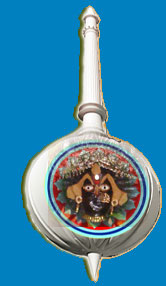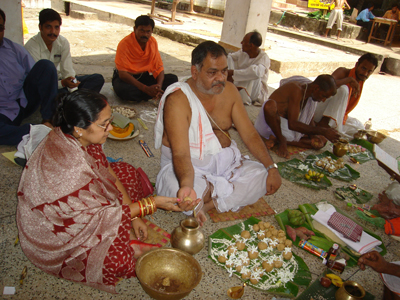Nābhigayā

There is a fathomless well in the close proximity of Goddess Biraja inside the compound which is known as Nabhikupa or Nābhigayā where piṇḍas are offered to the ancestors. As it is a famous Pitṛ-Tīrtha, Hindu religious people from all over India and abroad come over here for the purpose of offering piṇḍas (oblations) to their ancestors in the course of their pilgrimage.
There are two episodes to illustrate the glory and glamour of Biraja Kṣetra or modern Jajpur that have been depicted beautifully in puranic texts. The episode in the Gayā Mahātmya section of the Vayu purāṇa relates a story thus-In the Svetavarāha kalpa a very powerful demon Gayā, who was sincerely devoted to Lord Viṣṇu, performed severe penance on the Kolāhala Mountain for thousands of years in order to achieve utmost purity of body and mind. Gods became scared at his penance and approached Lord Viṣṇu who accompanied them to the demon Gayā in order to grant his desire. The demon on the fulfillment of his desire, attained purity and whosoever touched his body went to Viṣṇuloka (the abode of Lord Viṣṇu) with a liberated soul. The Yamaloka (the abode of the God of death) was desolated Yama, the God of death, in the company of Indra (the God of rain) with other Gods approached Brahma (the creator) who sought the counsel of Viṣṇu. At the advice of Viṣṇu, Brahma entreated Gayā for giving away his pure body for the purpose of a sacrifice, Gayā readily agreed to the proposal and immediately laid down his physical form on the earth in a south-western direction where by his head rested on the Kolāhala Mountain beside the river Falgu his navel on Biraja beside the river Vaitaraṇī and his feet at Pīṭhapuram beside the river Godāvarī, Brahma performed a sacrifice on the Navel of Gayā at Biraja. As Gayā’s body was unstable and unfavorable for performing the sacrifice, he entreated Viṣṇu and other Gods to help  him make the body stable, Viṣṇu wielded his Gadā (club) and made Gayā’s body stable. Gayā complained of his unnecessary torture though he submitted to the desire of the gods. So Viṣṇu asked him to choose a boon for offering his body for a greater interest whereby Gayā chose that Brahma, Viṣṇu and Siva may remain in the three Places where his navel, head and feet fell as long as the earth, mountains, the sun, the moon and, the stars last and let the abodes of these three Gods turn in to Pitṛ-tirthas, The desire of Gayā was granted and Viṣṇu remained at Gayā (kolāhala mountain) where the head of the demon fell. Brahma: adored the Biraja Kṣetra or modern Jajpur where the navel fell and Siva was associated with Pīṭhapuram where the feet rested. Thus the ancient Biraja Kṣetra turned in to a Pitṛ Tīrtha and NaviGayā was evolved out of the navel of demon Gayā, The Biraja Kṣetra mahātmya illustrates the same story with the slightest modification and justified VirajāKṣetra as a Pitṛ-Tīrtha similar to PādaGayā Tīrtha at Pithapuram and Mastaka Gayā Tīrtha beside the river falgu in Magadha or the present Bihar.
him make the body stable, Viṣṇu wielded his Gadā (club) and made Gayā’s body stable. Gayā complained of his unnecessary torture though he submitted to the desire of the gods. So Viṣṇu asked him to choose a boon for offering his body for a greater interest whereby Gayā chose that Brahma, Viṣṇu and Siva may remain in the three Places where his navel, head and feet fell as long as the earth, mountains, the sun, the moon and, the stars last and let the abodes of these three Gods turn in to Pitṛ-tirthas, The desire of Gayā was granted and Viṣṇu remained at Gayā (kolāhala mountain) where the head of the demon fell. Brahma: adored the Biraja Kṣetra or modern Jajpur where the navel fell and Siva was associated with Pīṭhapuram where the feet rested. Thus the ancient Biraja Kṣetra turned in to a Pitṛ Tīrtha and NaviGayā was evolved out of the navel of demon Gayā, The Biraja Kṣetra mahātmya illustrates the same story with the slightest modification and justified VirajāKṣetra as a Pitṛ-Tīrtha similar to PādaGayā Tīrtha at Pithapuram and Mastaka Gayā Tīrtha beside the river falgu in Magadha or the present Bihar.
The second episode craves for justifying Biraja Kṣetra as a great Śakti pīṭha that was known from the pre-Gupta period. Hence it is a post- facto attempt to put forth the revised version of an earlier tradition of Daksa – Yajna Vidhvamsan- prakaraṇa to sanctify the place. Though the name of Biraja Kṣetra is not found to be associated with any of the limbs of SATI in any of the earlier texts like Kurma purāṇa and Matsya purāṇa etc. Some latter texts of tantra have done so. The story of Daksa – Yajna - Vidhvamsana runs thus – SATI, the consort of Siva commits suicide in the sacrificial pit of his father Daksaprajāpati listening to the invectives aimed at her husband Siva. At this Siva in a fit of rage carries sati’s dead body on the shoulder and starts performing Taṇḍava (a furious dance) dance that indicates the welcome of Pralaya or total destruction of the universe. At the request of the frightened gods, Viṣṇu comes forward in order to save the universe and cuts down sati’s body in to pieces by his wheel weapon. The limbs of Sati fell at different places of India and gave rise to Śākta pīṭhas, Sati’s navel is said to have fallen in the VirajāKṣetra and so it became known as Nabhipīṭha, a great Śāktapīṭha. However, the tradition goes that the Navel of the demon Gayā and Goddess Sati is the common element and in both the cases Viṣṇu has cut down the body to cause the Navel fall as a result of which the place was glorified either as a Pitṛ-Tīrtha or as a śāktapīṭha. Here again there is an interlinking of the rise of Śakti cult with the Vaishnavite faith in the form of an invisible amalgamation and mysterious process of assimilation between both the religious ideas. There is a novel tradition here that people after offering piṇḍas to their ancestors must have to pray to Goddess Biraja to receive their oblations on behalf of their ancestors instead of praying to lord Viṣṇu as is customary everywhere in India. People from all over India come here to offer piṇḍas to their ancestors at Nābhigayā and a visit to Goddess Biraja throughout the year. The best period for offering such piṇḍas is during the Pitṛ-paksa(Mahālayā) in the month of September i.e. During the dark fortnight of the month of Bhādrapada.
cult with the Vaishnavite faith in the form of an invisible amalgamation and mysterious process of assimilation between both the religious ideas. There is a novel tradition here that people after offering piṇḍas to their ancestors must have to pray to Goddess Biraja to receive their oblations on behalf of their ancestors instead of praying to lord Viṣṇu as is customary everywhere in India. People from all over India come here to offer piṇḍas to their ancestors at Nābhigayā and a visit to Goddess Biraja throughout the year. The best period for offering such piṇḍas is during the Pitṛ-paksa(Mahālayā) in the month of September i.e. During the dark fortnight of the month of Bhādrapada.
